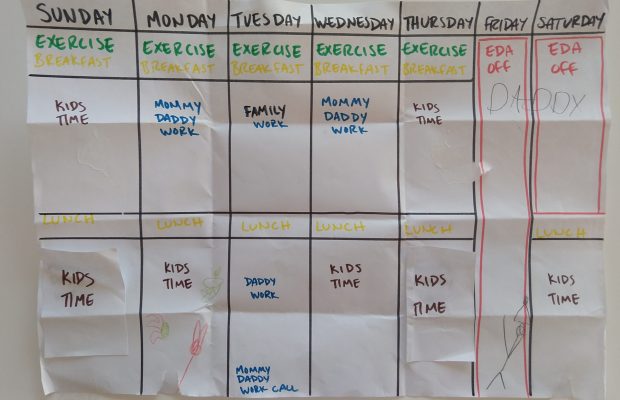Greetings Everyday Spy,
Welcome to your newest #SpyHACK!
The last few months have been an interesting exercise for me and my family.
Dealing with a global crisis while running a business and raising a couple kids feels a lot like being deployed to a combat zone.
- The work never ends.
- There are landmines and sniper shots all around you.
- Days blend together in a haze of repetition and exhaustion.
If you have been feeling ‘trapped’ at home the last few weeks, you are not alone.
My wife and I spent many months deployed to conflict regions with CIA. Sometimes we shipped out together. Sometimes we were apart.
But we both came to appreciate the way ‘deployed life’ simplifies the chaos of ‘real life.’
- You never have to worry about dressing up.
- The food is always the same basic mix of ingredients.
- The day naturally breaks into a series of core activities that you repeat week after week.
More than the danger pay, career requirements, or promotional advantages, CIA officers look forward to living an uncomplicated life on forward operating bases.
If you have ever experienced basic training or a military deployment, you know exactly what I’m talking about. There is a special kind of freedom that comes from embracing a routine – even if it is set by someone else!
The foundation of every deployment is something known as a ‘time block’ or a ‘segment.’
A time block is a set period of time reserved for a specific activity: exercise, eating, recuperation, personal time, etc.
Segments – time blocks – can be broken into any length of time.
- At the US Air Force Academy, my daily schedule was broken into 50 minute segments.
- In the Nuclear Missile field, my segments were 120 minutes each.
- When I give espionage training courses, I teach in 40 minute increments.
While there is plenty of science to help choose the right length for an activity, the real power of time blocking comes from the boundaries it sets.
For example, when your exercise segment starts, you can focus your energy on the workout knowing you don’t have anything else until the segment ends. When your last work segment ends, you don’t have to worry if you ‘forgot to do something’ because you know exactly when you’ll start working the next day.
Time blocks build a sense of confidence and comfort. And in that confidence, your mental resources (critical thinking, creativity, risk tolerance, etc.) can be optimized, anxiety/uncertainty decrease, and your quality of rest/sleep is maximized.
Our family home-schools, travels the world, and runs a digital business that serves private and government customers.
We are constantly experiencing new time zones, cultural stressors, technical and governmental hurdles (in multiple languages…), and all the personal conflicts common in any family…
- “Sina, stop teasing your sister…”
- “Alai, don’t pull on Sina’s underwear…”
- “Jihi, why do you keep moving my notebook?!”
And the same tool that helped us optimize our resources in far flung firebases helps us succeed now, in the everyday conflict zone.
Here is how we built our current segment schedule and how you can build your own:
Step 1: Identify Optimal
This is the most important and most misunderstood step in the process.
People mistake ‘Optimal’ for ‘Expectation.’ I understand that we are conditioned to work a 5 day work week, where each day is 8 hours. I get that typical businesses have core business hours and others operate with standard shifts. But doing what everyone else does is filling an ‘expectation’… it is not doing what is naturally optimal for you.
When CIA forward deploys its officers, there are no fixed shifts or core hours.
The fight is 24/7/365 – it never stops. So your work is endless. The only way to keep up with the constantly evolving battlefield is to work when your mind and body are best suited to work.
- Some people are most creative and energetic before 12pm.
- Others come to life after a good workout.
- Some folks are most productive in the late hours of the night and early hours of the morning.
Every intelligence officer understands their natural peak state – their natural ‘optimal’ time – and they build their daily segments around it.
In my family, my optimal time isn’t the only one I have to work with. I have two kids, a wife, and a live-in nanny. Everyone’s ‘optimal’ must be identified for our routine to be as effective and efficient as possible.
- My mind is the clearest between 8am-1pm. After 2pm, I’m ready for physical activity instead of mental exercise.
- Jihi has the lowest levels of anxiety between 9am-3pm. As the day wears on, she starts getting distracted and her personal discipline decreases.
- My 7 year old son has two windows of prime energy; 9am-11am and again 3pm-5pm. Outside of those hours he naturally hides away to recharge on his own.
- My 2 year old daughter is a ticking time bomb that goes off twice a day. Her attitude and happiness are highest at 7am and again at 3pm, then she slowly degrades until she explodes and falls asleep about 5 hours later, resetting the bomb.
- Our nanny is a machine, focused and patient in 3 hour increments with a much-needed 1 hour break in between.
That is our optimal.
Step 2: Build with Blocks
Once you ‘identify optimal,’ you will already see some natural segments/blocks start to take shape.
The next step is to grab a sheet of paper (or a spreadsheet for you techies) and start lining everything up!
Draw a 24-hour long timeline from left to right on your page. Person by person, draw their ‘optimal’ blocks into the timeline, stacking blocks that overlap. You can divide blocks anyway you choose – in 5 minute increments or 5 hour increments. But you have to stack them to see where they overlap.
Once everyone’s optimal is drawn in, look for the blocks with the most overlap.
When my wife and I first did this, the kids were very young and still in school. We made a few powerful discoveries.
- The kids were most ‘optimal’ when they were at school, not when they were with us.
- We were most ‘optimal’ when the kids were at a school, not when we were with them.
- The hours when the family was together (early morning, evening/bedtime) were collectively everyone’s most sub-optimal time.
This discovery is actually what led us to start homeschooling. And since doing so, we have been able to align everyone’s optimal time so we can spend wonderful, joyful hours together instead of constantly fighting every morning and every night.
Where optimal blocks have the most overlap, schedule your resource-intensive activities.
These are the blocks where Jihi and I work, where the kids learn, where the nanny cooks/cleans, where the family goes on field trips, or where we all sit together to enjoy a family movie.
The areas where optimal hours do not align become the areas where you divide your time to support one another.
When my mind starts to tap out around 1pm, I go rough-house with my son while the nanny puts the baby down for a nap and Jihi keeps working alone. When dinner time rolls around, my wife and I tackle the kids together while the nanny gets an afternoon breather before she cleans up the kitchen for the night.
We don’t make the kids learn when they are tired, and they don’t fight back against us when we are tired. Instead, we all sit together and color, play with LEGOs, or read a comic book together because we recognize everyone is in a shared energy lull.
The net result is easier days and higher quality time doing the things we care about: working, playing, and learning
Step 3: Make it Sticky
The next biggest mistake people make when they block time is over-correcting their schedule.
You have to trust the process you went through to build your segments. You spent time and effort ‘finding optimal’ and ‘building with blocks’, now you have to trust that your effort will pay off.
Segments do not always yield immediately positive results.
First of all, the segments are new to everyone – and new is never easy. Second, you have to shake-off years of conditioning that programmed you for the standard work week. Lastly, whatever your optimal schedule looks like is sure to look different from everyone and everything else in your life.
- Grocery shopping on a different day/time looks different.
- Medical appointments on a different day/time may have different doctors.
- Recurring conference calls stay the same even though your schedule has changed.
Give your new segments 7 full days to settle out.
In those seven days you will see how the reduced stress and increased energy offsets the initial challenges. Your improved attitude (and the better attitudes of everyone else in the family) gives you the mental resources you need to overcome minor inconveniences that can derail others.
Fight the urge to constantly change, adjust, and fine-tune your time blocks.
If you slip into the trap of over-correcting, you end up seeing the segmented schedule as a new stressor and eventually give up on it all together. Then you slip back into the old, reactive way of doing things that never suited you to start with.
You can optimize your day, your week, and your entire life the same way elite operators optimize in a warzone.
As long as you trust your process and don’t ‘fix’ yourself into a hurt locker.
Godspeed, #EverydaySpy
Author: Andrew Bustamante, Founder of www.EverydaySpy.com. Andrew is a former covert CIA Intelligence officer, decorated US Air Force Combat Veteran, and respected Fortune 500 senior advisor. Learn more from Andrew on his Podcast (The Everyday Espionage Podcast) and by following @EverydaySpy on your favorite social media platform.


